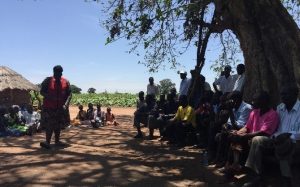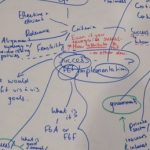Author(s): Joy Waddell, Ailsa Holloway, Carinus de Kock (Stellenbosch University)
The FATHUM team in South Africa has selected the Langeberg Municipality in the Western Cape as the case study site for this research. South Africa’s Western Cape, which is home to over five million people, is known as “the Cape of Storms.” Due to the Langeberg Municipality’s extensive disaster history, steep topography, and remoteness of its rural communities, it was identified as a hotspot for high-impact weather events that increase the likelihood of destructive flash flooding. The Langeberg Municipality, which is one of five local municipalities within the Cape Winelands District of the Western Cape, is located about 180 km east of Cape Town.
 Location of the Langeberg Municipality in the Western Cape, South Africa |
The Langeberg Municipality has a population of 98,000 involved in a diverse economic base that includes mainly agriculture, forestry, and fisheries (15.3% of GDP, 23.1% of workforce in 2014), tourism, and manufacturing (17.5% of GDP in 2015). The Langeberg’s major towns (Montagu, Robertson, Ashton, and Bonnievale) are surrounded by complex mountain topography. The steep gradient of these mountains and the elongated and lobed shapes of the catchments in this area increase the likelihood of flooding, particularly flash flooding.
 Mountainous terrain in the Langkloof, Langeberg Municipality |
 River’s proximity to the Cogmanskloof pass, near Montagu |
From 2003 to 2014, the Langeberg Municipality experienced six disasters associated with severe weather events caused by cut-off low pressure weather systems. The resulting disasters were characterised by widespread flooding, with impacts reported across the Western Cape. During that time, the Langeberg reported total financial losses of around ZAR 23.6 million, with 6,424 people affected or requiring assistance.
 Flooding in Aston, 2003 |
 Number of people affected in the Langerberg Municipality from disasters associated with cut-off low systems |
The town of Montagu, with its population of 15,176, is situated at the confluence of two major rivers. The Cogmanskloof pass through the Langeberg Mountains, near Montagu, is a major road that has flooded, cutting off the northern and southern parts of the Langeberg and causing logistical challenges, especially for response units such as emergency services, disaster management, police, and traffic services during a disaster.
Other contributing factors increasing local flood risk include:
• Changing land-use patterns, which increase surface run-off;
• Location of many towns and critical infrastructure along major rivers and in river valleys;
• Frequent wildfires linked to fire-adapted vegetation (e.g., fynbos, grasslands, Rynosterveld) and alien vegetation (e.g., pine forests), which also increase surface run-off;
• Increasing sediment accumulation (aggradation) in rivers, also linked to increased alien vegetation (e.g., reeds) in riparian zones.
 Debris clogging a bridge leading into Montagu, 2015 |
 Damage at Cogmanskloof pass, 2015 |
There is limited weather radar coverage in the Western Cape, not only because there are not enough instruments in place collecting the data, but the mountainous topography means that accurate inland flash-flood forecasting is blocked by the Langeberg mountain range, As shown in the Figure below, this leaves very little of the Western Cape covered by accurate weather radar, which severely restrains accurate forecasting and warning in the province. The implications were clearly highlighted during the 2011 and 2012 events, when weather warnings disseminated by the South African Weather Service did not specify areas such as the Langeberg Municipality. Heavy rainfall and flooding events in the Langeberg’s towns, such as Ashton, Montagu, and Robertson, claimed several lives, including that of an ambulance attendant. In both instances, preparedness mechanisms that should have been activated were not triggered, as flash flood warnings were not issued for the Langeberg Municipality.

Map of the Western Cape, highlighting the optimal weather radar coverage (green and white circles), compared with actual coverage (red shading) (Taken from Pharoah et al. 2016)
For more information on cut-off low weather systems in the Western Cape and their impact on the Langeberg Municipality, see: Pharoah et al. (2016). “Off the radar: Synthesis report. Severe weather events 2011-2014 and their impacts in the Western Cape Province, South Africa.” http://pdf.usaid.gov/pdf_docs/PA00M95M.pdf


















 Icebreaker activities and discussion: The FATHUM team had 1-on-1 speed-introductions to each other, trying to find the most interesting / novel thing they had in common. Then they were asked to ‘vote with their feet’, placing themselves in different parts of the room depending on their disciplinary background, applied or theoretical nature of research, and previous history of working with the Red Cross / Red Crescent Movement.
Icebreaker activities and discussion: The FATHUM team had 1-on-1 speed-introductions to each other, trying to find the most interesting / novel thing they had in common. Then they were asked to ‘vote with their feet’, placing themselves in different parts of the room depending on their disciplinary background, applied or theoretical nature of research, and previous history of working with the Red Cross / Red Crescent Movement.
 Work Package 3 Activity: Sara de Wit led groups organised by discipline in a ‘mapping the conversation’ exercise, discussing “What makes a successful implementation of FbF”, and “What are the barriers to FbF being implemented?”
Work Package 3 Activity: Sara de Wit led groups organised by discipline in a ‘mapping the conversation’ exercise, discussing “What makes a successful implementation of FbF”, and “What are the barriers to FbF being implemented?”